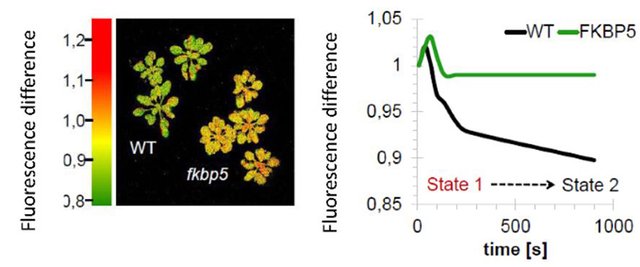Plants acclimate to fluctuating light conditions in the short-term. Whilst excess of light induces the photoprotective non-photochemical quenching (NPQ) mechanism a change in spectral composition leads to unbalanced excitation of one of the two photosystems (PS). This effect is counteracted by antenna movement restoring the excitation balance and enhancing photosynthetic light use efficiency. The thylakoid associated kinase STN7 phosphorylates LHC and induces state transitions.
In this work three plastid FKBPs were investigated which were predicted to be localized to the thylakoid lumen and might have functions in regulation of the light reaction. The loss of function of one specific FKBP leads to loss of antenna movement (seen in figure 1 by the chlorophyll fluorescence imaging system FluorCam). Blue-native analysis let suggest that the mutant is locked in state I where the LHCII is phosphorylated. This finding was confirmed by low temperature chlorophyll fluorescence spectroscopy. If the mutants are kept under altered spectral light composition for longer time they fail to perform a long-term response (LTR). Therefore, it is very likely that this FKBP has an important function in light regulation enhancing photosynthetic performance and plant fitness.
This FKBP is the first protein from the periphery of the thylakoid membrane which could be directly involved in state transitions giving rise for the possibility of a novel regulatory mechanism in light acclimation.
Further information: http://www.bio.uni-frankfurt.de/43969659/forschung">http://www.bio.uni-frankfurt.de/43969659/forschung
___
Ina Burghardtconducted this work at the Chair of Plant Cell Physiology in the group of Dr. Lars Dietzel.

